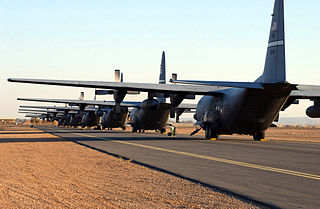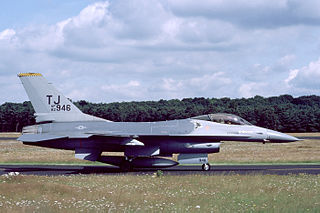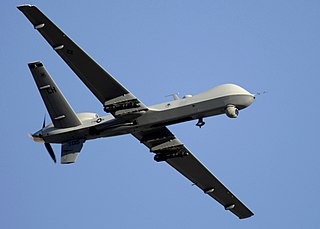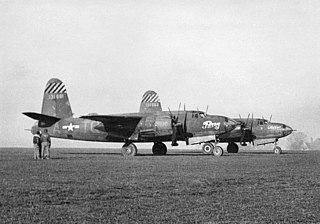
The 91st Bomb Group (Heavy) was an air combat unit of the United States Army Air Forces during the Second World War. Classified as a heavy bombardment group, the 91st operated B-17 Flying Fortress aircraft and was known unofficially as "The Ragged Irregulars" or as "Wray's Ragged Irregulars", after the commander who took the group to England. During its service in World War II the unit consisted of the 322nd, 323rd, 324th, and 401st Bomb Squadrons. The 91st Bomb Group is most noted as the unit in which the bomber Memphis Belle flew, and for having suffered the greatest number of losses of any heavy bomb group in World War II.

Royal Air Force Kimbolton or more simply RAF Kimbolton is a former Royal Air Force station located 8 miles (13 km) west of Huntingdon, Cambridgeshire, England.

The 487th Air Expeditionary Wing is a provisional United States Air Force unit assigned to the United States Air Forces in Europe. As a provisional unit, it may be activated or inactivated at any time. The unit's last known assignment was in 2003 at Cairo West Air Base, Egypt, during Operation Iraqi Freedom.

The 485th Air Expeditionary Wing is a provisional United States Air Force unit assigned to Air Combat Command. As a provisional unit, the 485 AEW may be inactivated or activated at any time by Air Combat Command. The wing was last known to be active during Operation Iraqi Freedom in 2003 at Tabuk Regional Airport, Saudi Arabia, in 2003.

The Commandant of Cadets is a named organization of the United States Air Force based at the Air Force Academy in Colorado Springs, Colorado. Until August 2006 the commander of the 34th Training Wing was "dual-hatted" as the Commandant of Cadets at the Academy. In that month the 34th Wing became a named organization.

The 701st Airlift Squadron is part of the 315th Airlift Wing at Charleston Air Force Base, South Carolina. It operates Boeing C-17 Globemaster III aircraft providing global airlift.

The 863rd Bombardment Squadron is a former United States Army Air Forces unit. It was first organized as the 518th Bombardment Squadron in October 1942, when it replaced a National Guard unit participating in antisubmarine patrols off the Atlantic coast, becoming the 13th Antisubmarine Squadron in November. When the Navy took over the coastal antisubmarine mission in August 1943, the squadron moved to the western United States, where it formed the cadre for the 493rd Bombardment Group and was redesignated as the 863rd. It moved to England in the spring of 1944 and participated in the strategic bombing campaign against Germany until April 1945. It returned to the United States and was inactivated in August 1945.

The 857th Bombardment Squadron is one of the two predecessors of the 557th Tactical Air Support Squadron, an inactive United States Air Force unit, formed in 1985 by the consolidation of the 857th with another inactive bombardment squadron. It has never been active under its most recent designation.

The 401st Air Expeditionary Group is a provisional United States Air Force unit assigned to United States Air Forces in Europe to be activated or inactivated at any time as needed. It is stationed at Ramstein Air Base, Germany.

The 703d Tactical Air Support Squadron is an inactive United States Air Force unit. It was last assigned to the 507th Tactical Air Control Wing at Shaw Air Force Base, South Carolina, where it was inactivated in June 1988.

The 615th Tactical Fighter Squadron is an inactive United States Air Force unit. It was last assigned to the 35th Tactical Fighter Wing at Phan Rang Air Base, South Vietnam, where it was inactivated on 15 July 1971.

The 614th Tactical Fighter Squadron is an inactive United States Air Force unit. It was last assigned to the 401st Operations Group at Torrejon Air Base, Spain, where it was inactivated on 1 January 1992.

The 613th Tactical Fighter Squadron is an inactive United States Air Force unit. It was last assigned to the 401st Tactical Fighter Wing, stationed at Torrejon Air Base, Spain, where it was inactivated on 28 June 1991.

The 612th Tactical Fighter Squadron is an inactive United States Air Force unit. It was last assigned to the 401st Tactical Fighter Wing at Torrejon Air Base, Spain, where it was inactivated on 1 October 1991.

The 511th Bombardment Squadron is an inactive United States Air Force unit. It was last assigned to the 351st Bombardment Group at Fairfax Field, Kansas, where it was inactivated on 27 June 1949.

The 322d Expeditionary Reconnaissance Squadron is a provisional unit of the United States Air Force, assigned to Air Combat Command to activate or inactivate as needed.

The 324th Expeditionary Reconnaissance Squadron is a provisional United States Air Force unit. It is assigned to the 409th Air Expeditionary Group at Naval Air Station Sigonella, Italy.

The 323d Strategic Reconnaissance Squadron is an inactive United States Air Force unit. Its last was assigned to the 91st Strategic Reconnaissance Wing, stationed at Lockbourne Air Force Base, Ohio. It was inactivated on 8 November 1957.

The 969th Airborne Warning and Control Squadron is an inactive United States Air Force unit. It was formed in 1985 by the consolidation of the 559th and 659th Bombardment Squadrons.

The 860th Bombardment Squadron is a former United States Army Air Forces unit that was assigned to the 493d Bombardment Group during World War II. It was part of the last bombardment group to be assigned to Eighth Air Force. It flew combat missions until V-E Day, then returned to the United States for inactivation. In 1985, the squadron was consolidated with the 660th Bombardment Squadron, a Strategic Air Command unit that flew Boeing B-47 Stratojets during the Cold War. Although the two squadrons were consolidated as the 967th Airborne Warning and Control Squadron, they have never been active under that designation.





















